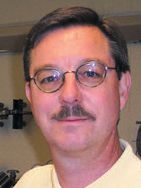The gold standard for wear
Drs. Wilfred T. Tysoe & Nicholas D. Spencer | TLT Cutting Edge February 2009
A Canadian team of researchers has developed a method of measuring component wear that doesn’t involve radioactive materials.
The measurement and minimization of wear are often central in designing mechanical components. Unfortunately, the very low wear rates that are the most interesting and useful are also those most difficult to measure precisely.
For example, modern, high-efficiency engines have wear rates that are on the order of nanometers/hour. One of the most accurate methods is based on radionuclide techniques that involve using an accelerator to generate a surface region that is radioactive and then measuring the amount of radiation in the lubricant caused by the wear process. This approach is useful for continually measuring wear rates
in situ, but obviously there are many environments where using radioactive materials is inconvenient.
A team led by professor Peter Norton at the University of Western Ontario, Canada, recently developed an analogous approach that avoids using radioactivity. This method involves implanting a surface region with gold atoms, (
197Au) at energies chosen to match the implantation depth to the desired measurement parameters. For example at 90 keV, gold ions penetrate a few tens of nanometers into ferrous metals and alloys. Rather than using radioactivity to monitor material removal as is done with radionuclide techniques, they used Rutherford backscattering (RBS) instead.
RBS was originally developed in the early part of the 20th century by Ernest Rutherford, who used it to disprove the “plum-pudding” model of the atom, which postulated that the atom consisted of negative electrons immersed in a sea of positive charge. It was found that positively charged α-particles incident on a gold foil were scattered in a backward direction, which was only possible if all the positive charge of the atom was concentrated in a small positive “nucleus,” thereby invalidating the plum-pudding model and paving the way for understanding atomic and molecular structure.
The energy of the back-scattered particles from a given depth in a given material depends on the mass of the nucleus. The Ontario group used this approach, rather than radioactivity, to measure material removal from the film by backscattering carbon ions and measuring their energy to distinguish gold from other elements, for example, iron, copper, silicon, etc., in the sample.
The ions also lose energy as they pass through the sample so that careful measurements of the energy distribution of the backscattered ions from the gold can be converted into a depth profile of the gold that has been implanted into the sample. This in turn can be converted into a calibration of the amount of gold lost from the sample vs. the worn depth. Because of the small gold implantation depth, this curve is very sensitive to wear of the top few tens of nanometers and is thus ideal for ultralow wear measurements, even in the presence of surface films.
Since ion implantation is well known to modify materials’ mechanical properties, the gold concentration was limited to ~0.1 to 1% of that typically used for surface modification, and measurements of mechanical properties using an indenter showed no statistical differences between implanted and non-implanted samples.
Wear experiments were carried out using a pin-on-flat configuration using AISI-52100 steel with a mineral oil alone and containing a typical engine antiwear additive, zinc dialkyl dithiophosphate (ZDDP). No statistical differences in friction coefficient were found for samples containing various doses of implanted gold.
However, the samples were rapidly depleted of gold when rubbing in just the base oil, showing an initial wear rate of ~1.7×10
-7 mm
3/N m after about 1 minute, quickly decreasing to about 1×10
-8 mm
3/N m after 30 minutes of sliding. Similar experiments were carried out for an oil with 1.2% ZDDP. The amount of gold removed from the sample was significantly reduced, from about 27% when using only the base oil, to less than 5% when ZDDP was added. The ability to measure the depth profile of the gold also enabled changes due to plastic deformation or film growth to be monitored at the same time as measuring low wear rates.
FOR FURTHER READING:
Li, Y.-R., Shakhvorostov, D., Pereira, G., Lachenwitzer, A., Lennard, W.N., and Norton, P.R. (2009) “A Novel Method for Quantitative Determination of Ultra-low Wear Rates of Materials, Part I: On Steels,”
Tribology Letters,
33 (2), pp. 143-152.
Li, Y.-R., Shakhvorostov, D., Lennard, W.N., and Norton, P.R. (2009) “A Novel Method for Quantitative Determination of Ultra-low Wear Rates of Materials, Part II: Effects of Surface Roughness and Roughness Orientation on Wear,” Tribology Letters, 33 (1), pp. 63-72.
 Eddy Tysoe is a Distinguished Professor of Physical Chemistry at the University of Wisconsin-Milwaukee. You can reach him at wtt@uwm.edu
Eddy Tysoe is a Distinguished Professor of Physical Chemistry at the University of Wisconsin-Milwaukee. You can reach him at wtt@uwm.edu.
 Nic Spencer is professor of surface science and technology at the ETH Zurich, Switzerland. Both serve as editors-in-chief of STLE-affiliated Tribology Letters journal. You can reach him at nspencer@ethz.ch
Nic Spencer is professor of surface science and technology at the ETH Zurich, Switzerland. Both serve as editors-in-chief of STLE-affiliated Tribology Letters journal. You can reach him at nspencer@ethz.ch.